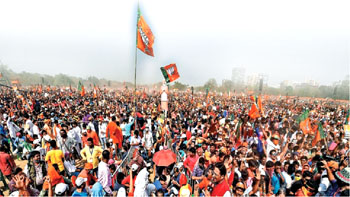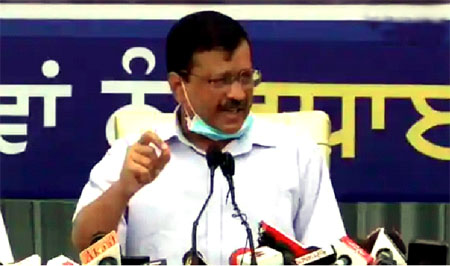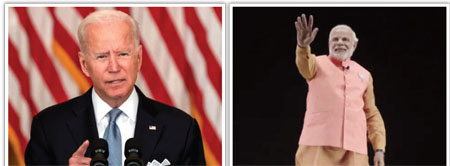Ergonomics in the era of post-truth have been engineered in various ways for electoral gains. Behavioural and cognitive facets of the electorate vis-à-vis ergonomics have become important aspects of being considered while formulating and deploying tools for political campaigns in the contemporary world. For instance, propaganda campaigns effectively and successfully used social media, closely correlated with data analytics and surveillance tools, to secure mandates in the United States Presidential Elections 2016 and the Brexit referendum in the United Kingdom. Everything right from how the people make political decisions and form ideological inclinations and political attitudes to how voters interact in political coalitions and evaluate political candidates are infused with this ergonomic engineering at the behavioural, emotional, mental and social levels.
`Post-truth’ has become a fairly well-known buzzword in politics today. Selected as the word of the year in 2016 by the Oxford Dictionary, it is defined as “relating to or denoting circumstances in which objective facts are less influential in shaping public opinion than appeals to emotion and personal belief.” Regardless of post-truth, recent research has shown that emotions can affect decision-making in disparate ways that do not necessarily undermine rationality but relatively moderate how they make decisions. Increasingly, adeptness of politicians in being able to wield virtual tools of effective engagement has become a gauge of their capabilities. Novel innovations in information exchange have become the new tools for engineering opinions and ergonomics in the political foray these days, in a somewhat regular and day-to-day manner, right at the voters’ proverbial doorstep.

In India, with the increased accessibility of cellular technology and burgeoning reach of disparate entities in the political realm on the virtual networks, it has become so easy to reach out to the people from across the country, with everything from disinformation campaigns and fake news to genuine campaign-points and propaganda media-elements. When used for constructive information, dissemination and user-engagement, political content on virtual platforms and networks can help facilitate consultation and discussion on topics of national interest and relevance, we increasingly see the emergence of hyperpartisan media, clickbait websites and bot/troll armies online that spread political disinformation for ideological and pecuniary reasons. Interestingly, in a recent study, it was seen that the response and outrage (if any) in online political discourses, such as in disinformation pages on Facebook, arose out of an intricate interplay of political alignments, predominant political conditions and concurrent political events.
While India is still some way off from deploying neuropolitical tools in politics, the preeminence of technological tools for customisability, personalisation and effective tracking cannot be understated. In the recent State elections in 2022, particularly in Uttar Pradesh, technology played an important role, particularly in the wake of COVID-19 and the need for employing virtual ways to engage with voters. The BJP held various virtual rallies promoted and amplified by Facebook pages and WhatsApp groups. One of the exciting aspects of karyakartas employed on this front was the close link between content monitoring and information dissemination
Among different emotions that play a role in a voter’s choices and tendencies, anxiety is an important one. Anxiety has generally been found to increase the inclination of an individual to seek more information, regardless of the source and validity of the information. This could be particularly problematic if the information is misleading, unbalanced and inaccurate. This is why a polarised climate or campaigns to evoke paranoia are closely tied to the success of misinformation, disinformation and propaganda campaigns. The Brexit referendum is an excellent example of the same when certain politicians such as Nigel Farage dished out ridiculous claims and outlandish campaign points to cross-sections of the British populace whose insecurities and fears, relating to the job market, security and social balance, were stirred in a sustained manner to secure the `Leave’ vote. Technological tools have allowed politicians to gauge the anxiety of voters and critical tendencies and behavioural patterns. Current technologies can infer probabilistic information about our emotional responses, psychological traits, and mental states based on our interaction with varied technological devices and platforms, thereby facilitating a classification that bypasses traditional forms of psychological assessment. Politicians are increasingly using the possibilities of the Internet to communicate interactively with citizens, with the preference being towards personalisation around themselves and the possibility of personalisation of the engagement based on past online tendencies, preferences and inclinations of the voter. Evaluation and usage of digital footprints using artificial intelligence and machine learning may raise fundamental questions on consent and trust but are being used to create unique election campaigns and tools to win over voters worldwide in democracies. It has been found that political personalisation positively moderates the effect of interactivity on political involvement. An infamous example of this was when Cambridge Analytica harvested 50 million Facebook profiles in what was regarded as a significant data breach, to target American voters in the 2016 US Presidential elections. Personalisation was also visible in the Twitter political campaigns during the 2019 Indian elections, albeit more above-board.

We are now entering a new age of taking the deployment of technology even further with the advent of neuropolitics and neuro-marketing. We have now started looking at how the different activities in the brain play a role in forming political alignments and tendencies. A recent study showed that conservatism is generated in the dorsolateral prefrontal cortex, individualism in the medial prefrontal cortex and the temporoparietal junction, and radicalism in the posterior cingulate and ventral striatum. We see politicians and political parties’ curious use of technologies such as biofeedback, brain imaging, and facial coding. An interesting example would be the Institutional Revolutionary Party of Mexico, which used facial coding to help pick its best candidates. The Justice and Development Party in Turkey tracked the activity of faces and eyes, brain waves, skin, and heart rates of volunteers to see how effective and emotionally engaging political speeches by their leaders were. Neuropolitical campaigning does what surveillance and even technological pattern-recognition using digital footprint cannot do. While the latter is limited in scope due to the inability of many users to articulate thoughts and any inconsistency or lack of activity in political activities online, biological trackers such as neurobiology, brain waves, facial expressions, skin conductance responses and movements in the corrugator supercilii muscle can give away a voter’s opinions and feelings much better, thereby making them a better way to predict the voter’s behaviour at the polls. However, besides the serious ethical questions surrounding such technology, they also have technical limitations that must be accounted for.
Evaluation and usage of digital footprints using Artificial Intelligence and machine learning may raise fundamental questions on consent and trust but are being used to create unique election campaigns and tools to win over voters worldwide in democracies
While India is still some way off from deploying neuropolitical tools in politics, the preeminence of technological tools for customisability, personalisation and effective tracking cannot be understated. In the recent State elections in 2022, particularly in Uttar Pradesh, technology played an important role, particularly in the wake of COVID-19 and the need for employing virtual ways to engage with voters. The BJP held various virtual rallies promoted and amplified by Facebook pages and WhatsApp groups. One of the exciting aspects of karyakartas employed on this front was the close link between content monitoring and information dissemination, highlighting a basic form of feedback-based electioneering that is dynamic and personalised. Target messaging and countering negative publicity were essential pursuits in this direction. Other parties, such as the Congress and Samajwadi Party, were similarly utilising various technological tools for campaigning. Whether these qualify as ways of personalisation and engineered ergonomics in the electoral fray is debatable. Indian politics can benefit, with appropriate control, from employing new-age tools like neuropolitical electioneering, particularly in the areas of candidate selection and effective campaigning. However, one must be mindful of aspects such as those raised in the recent debate on ‘neuro-rights’ laws, with even discussion on the repercussions of being able to design hybrid humans with artificially enhanced mental abilities. The fear is that such technologies can be used to alter an individual’s thoughts, preferences, and interests. In this context, a discussion of Neuro-rights, which refer to the legal and ethical principles of freedom and entitlement related to an individual’s cerebral or mental domain, is important. This would fall under the right to informational self-determination and privacy, as broadly safeguarded in Article 21 of the Indian Constitution. With Artificial Intelligence giving the critical interpretive firepower to make Brain-Machine Interfaces (BMI) potential neuropolitical powerhouses, the need of the hour is to safeguard the liberties of the individual, even as we move towards developing another prospective dimension of our politics.














Comments